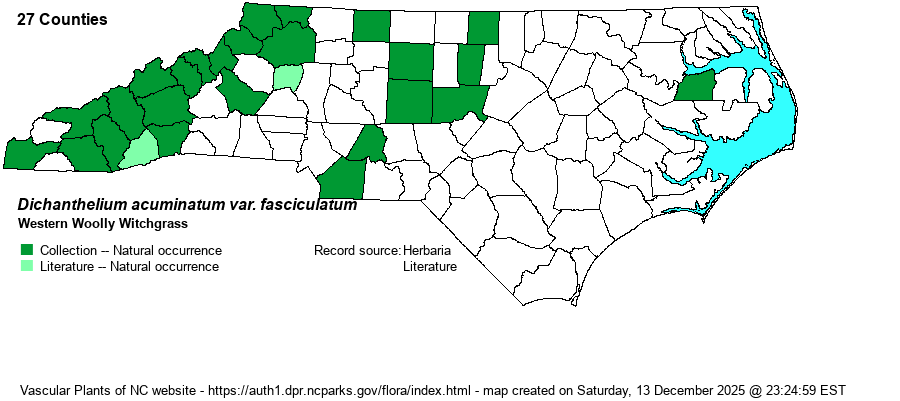| taxonName | relationship | relatedTaxonName | relatedTaxonRefText | relComments |
|---|
|
|
| Dichanthelium acuminatum var. fasciculatum | < | Panicum lanuginosum | Radford, Ahles, and Bell (1968) | |
| Dichanthelium acuminatum var. fasciculatum | > | Panicum lanuginosum var. fasciculatum | Gleason and Cronquist (1991) | |
| Dichanthelium acuminatum var. fasciculatum | > | Panicum lanuginosum var. fasciculatum | Fernald (1950) | |
| Dichanthelium acuminatum var. fasciculatum | > | Panicum lanuginosum var. fasciculatum | Gleason (1952) | |
| Dichanthelium acuminatum var. fasciculatum | > | Panicum lanuginosum var. tennesseense | Gleason and Cronquist (1991) | |
| Dichanthelium acuminatum var. fasciculatum | > | Panicum lanuginosum var. tennesseense | Gleason (1952) | |
| Dichanthelium acuminatum var. fasciculatum | > | Panicum lanuginosum var. implicatum | Gleason and Cronquist (1991) | |
| Dichanthelium acuminatum var. fasciculatum | > | Panicum lanuginosum var. implicatum | Fernald (1950) | |
| Dichanthelium acuminatum var. fasciculatum | > | Panicum lanuginosum var. implicatum | Gleason (1952) | |
| Dichanthelium acuminatum var. fasciculatum | = | Dichanthelium acuminatum ssp. fasciculatum | Flora of North America (1993b, 1997, 2000, 2002a, 2002b, 2003a, 2004b, 2005, 2006a, 2006b, 2006c, 2007a, 2009, 2010) | |
| Dichanthelium acuminatum var. fasciculatum | > | Panicum implicatum | Hitchcock & Chase (Manual of US Grasses) | |
| Dichanthelium acuminatum var. fasciculatum | > | Panicum implicatum | Flora of West Virginia | |
| Dichanthelium acuminatum var. fasciculatum | > | Panicum huachucae var. huachucae | Hitchcock & Chase (Manual of US Grasses) | |
| Dichanthelium acuminatum var. fasciculatum | > | Panicum huachucae var. huachucae | Small (1933, 1938) | |
| Dichanthelium acuminatum var. fasciculatum | > | Panicum huachucae var. fasciculatum | Hitchcock & Chase (Manual of US Grasses) | |
| Dichanthelium acuminatum var. fasciculatum | > | Panicum tennesseense | Hitchcock & Chase (Manual of US Grasses) | |
| Dichanthelium acuminatum var. fasciculatum | > | Panicum tennesseense | Small (1933, 1938) | |
| Dichanthelium acuminatum var. fasciculatum | > | Panicum huachucae var. silvicola | Small (1933, 1938) | |
| Dichanthelium acuminatum var. fasciculatum | >< | Dichanthelium acuminatum var. acuminatum | Kartesz (1999) | |
| Dichanthelium acuminatum var. fasciculatum | >< | Dichanthelium acuminatum var. acuminatum | Thomas (2008). The treatment of Dichanthelium sect. Lanuginosa (=D. acuminatum group) is based cl | |
| Dichanthelium acuminatum var. fasciculatum | >< | Dichanthelium acuminatum var. implicatum | Kartesz (1999) | |
| Dichanthelium acuminatum var. fasciculatum | >< | Dichanthelium acuminatum var. implicatum | Thomas (2008). The treatment of Dichanthelium sect. Lanuginosa (=D. acuminatum group) is based cl | |
| Dichanthelium acuminatum var. fasciculatum | > | Panicum huachucae | Flora of West Virginia | |
| Dichanthelium acuminatum var. fasciculatum | > | Panicum acuminatum var. fasciculatum | Thomas (2008). The treatment of Dichanthelium sect. Lanuginosa (=D. acuminatum group) is based cl | |
| Dichanthelium acuminatum var. fasciculatum | > | Panicum acuminatum var. unciphyllum | Thomas (2008). The treatment of Dichanthelium sect. Lanuginosa (=D. acuminatum group) is based cl | |
| Source: Weakley's Flora |

